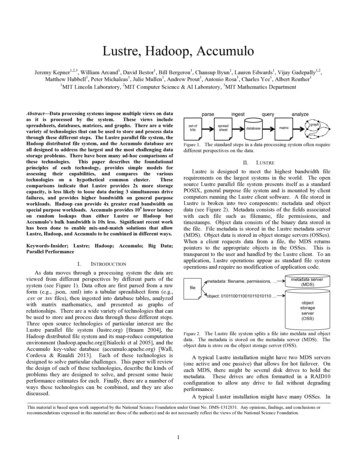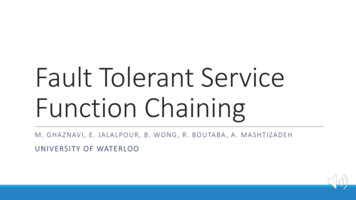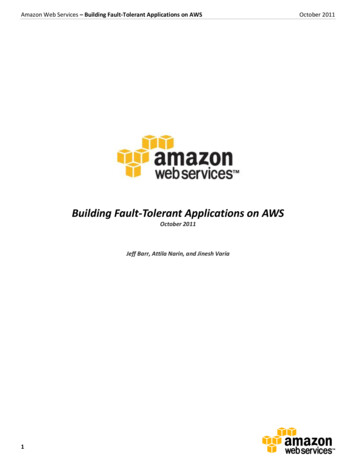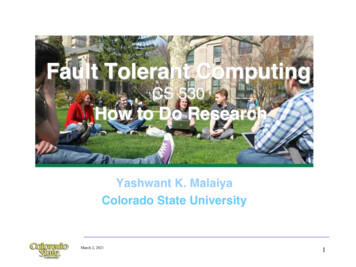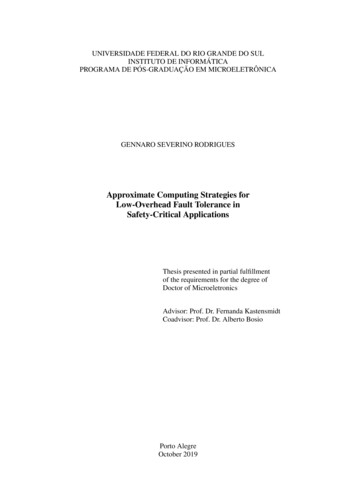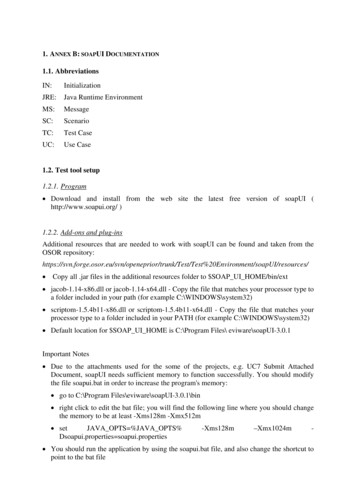
Transcription
F1 - The Fault-TolerantDistributed RDBMSSupporting Google's AdBusinessJeff Shute, Mircea Oancea, Stephan Ellner,Ben Handy, Eric Rollins, Bart Samwel,Radek Vingralek, Chad Whipkey, Xin Chen,Beat Jegerlehner, Kyle Littlefield, Phoenix TongSIGMODMay 22, 2012
Today's TalkF1 - A Hybrid Database combining the Scalability of Bigtable Usability and functionality of SQL databasesKey Ideas Scalability: Auto-sharded storage Availability & Consistency: Synchronous replication High commit latency: Can be hidden Hierarchical schema Protocol buffer column types Efficient client codeCan you have a scalable database without going NoSQL? Yes.
The AdWords EcosystemOne shared database backing Google's core AdWords businessadvertiserSOAP APIweb UIreportsJava / "frontend"ad-hocSQL usersC / "backend"DBlog aggregationad serversad approvalsspam analysisad logs
Our Legacy DB: Sharded MySQLSharding Strategy Sharded by customer Apps optimized using shard awarenessLimitations Availability Master / slave replication - downtime during failover Schema changes - downtime for table locking Scaling Grow by adding shards Rebalancing shards is extremely difficult and risky Therefore, limit size and growth of data stored in database Functionality Can't do cross-shard transactions or joins
Demanding UsersCritical applications driving Google's core ad business 24/7 availability, even with datacenter outages Consistency required Can't afford to process inconsistent data Eventual consistency too complex and painful Scale: 10s of TB, replicated to 1000s of machinesShared schema Dozens of systems sharing one database Constantly evolving - multiple schema changes per weekSQL Query Query without code
Our Solution: F1A new database, built from scratch, designed to operate at Google scale, without compromising on RDBMS features.Co-developed with new lower-level storage system, Spanner
Underlying Storage - SpannerDescendant of Bigtable, Successor to MegastoreProperties Globally distributed Synchronous cross-datacenter replication (with Paxos) Transparent sharding, data movement General transactions Multiple reads followed by a single atomic write Local or cross-machine (using 2PC) Snapshot reads
F1F1clientArchitecture Sharded Spanner servers data on GFS and in memory Stateless F1 server Pool of workers for query executionF1 serverF1 queryworkersFeatures Relational schema Extensions for hierarchy and rich data types Non-blocking schema changes Consistent indexes Parallel reads with SQL or Map-ReduceSpannerserverGFS
How We Deploy Five replicas needed for high availability Why not three? Assume one datacenter down Then one more machine crash partial outageGeography Replicas spread across the country to survive regional disasters Up to 100ms apartPerformance Very high commit latency - 50-100ms Reads take 5-10ms - much slower than MySQL High throughput
Hierarchical SchemaExplicit table hierarchies. Example: Customer (root table): PK (CustomerId) Campaign (child): PK (CustomerId, CampaignId) AdGroup (child): PK (CustomerId, CampaignId, AdGroupId)Storage LayoutRows and )
Clustered Storage Child rows under one root row form a clusterCluster stored on one machine (unless huge)Transactions within one cluster are most efficientVery efficient joins inside clusters (can merge with no sorting)Storage LayoutRows and )
Protocol Buffer Column TypesProtocol Buffers Structured data types with optional and repeated fields Open-sourced by Google, APIs in several languagesColumn data types are mostly Protocol Buffers Treated as blobs by underlying storage SQL syntax extensions for reading nested fields Coarser schema with fewer tables - inlined objects insteadWhy useful? Protocol Buffers pervasive at Google - no impedance mismatch Simplified schema and code - apps use the same objects Don't need foreign keys or joins if data is inlined
SQL Query Parallel query engine implemented from scratch Fully functional SQL, joins to external sources Language extensions for protocol buffersSELECT CustomerIdFROM Customer c PROTO JOIN c.Whitelist.feature fWHERE f.feature id 302AND f.status 'STATUS ENABLED'Making queries fast Hide RPC latency Parallel and batch execution Hierarchical joins
Coping with High LatencyPreferred transaction structure One read phase: No serial reads Read in batches Read asynchronously in parallel Buffer writes in client, send as one RPCUse coarse schema and hierarchy Fewer tables and columns Fewer joinsFor bulk operations Use small transactions in parallel - high throughputAvoid ORMs that add hidden costs
ORM Anti-Patterns Obscuring database operations from app developers Serial reads for loops doing one query per iteration Implicit traversal Adding unwanted joins and loading unnecessary dataThese hurt performance in all databases.They are disastrous on F1.
Our Client Library Very lightweight ORM - doesn't really have the "R" Never uses Relational joins or traversal All objects are loaded explicitly Hierarchical schema and protocol buffers make this easy Don't join - just load child objects with a range read Ask explicitly for parallel and async reads
ResultsDevelopment Code is slightly more complex But predictable performance, scales well by default Developers happy Simpler schema Rich data types - lower impedance mismatchUser-Facing Latency Avg user action: 200ms - on par with legacy system Flatter distribution of latencies Mostly from better client code Few user actions take much longer than average Old system had severe latency tail of multi-second transactions
Current Challenges Parallel query execution Failure recovery Isolation Skew and stragglers Optimization Migrating applications, without downtime Core systems already on F1, many more moving Millions of LOC
SummaryWe've moved a large and critical application suite from MySQL to F1.This gave us Better scalability Better availability Equivalent consistency guarantees Equally powerful SQL queryAnd also similar application latency, using Coarser schema with rich column types Smarter client coding patternsIn short, we made our database scale, and didn't lose any keydatabase features along the way.
Business Jeff Shute, Mircea Oancea, Stephan Ellner, Ben Handy, Eric Rollins, Bart Samwel, . Scalability of Bigtable Usability and functionality of SQL databases Key Ideas Scalability: Auto-sharded storage Availability & Consistency: Synchronous replication High commit latency: Can be hidden . just load child objects with a range read Ask .




